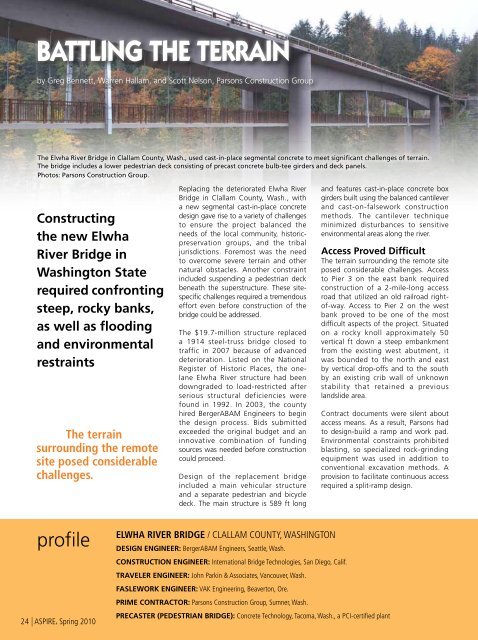ASPIRE Spring 10 - Aspire - The Concrete Bridge Magazine
ASPIRE Spring 10 - Aspire - The Concrete Bridge Magazine
ASPIRE Spring 10 - Aspire - The Concrete Bridge Magazine
You also want an ePaper? Increase the reach of your titles
YUMPU automatically turns print PDFs into web optimized ePapers that Google loves.
Battling the Terrain<br />
by Greg Bennett, Warren Hallam, and Scott Nelson, Parsons Construction Group<br />
<strong>The</strong> Elwha River <strong>Bridge</strong> in Clallam County, Wash., used cast-in-place segmental concrete to meet significant challenges of terrain.<br />
<strong>The</strong> bridge includes a lower pedestrian deck consisting of precast concrete bulb-tee girders and deck panels.<br />
Photos: Parsons Construction Group.<br />
Constructing<br />
the new Elwha<br />
River <strong>Bridge</strong> in<br />
Washington State<br />
required confronting<br />
steep, rocky banks,<br />
as well as flooding<br />
and environmental<br />
restraints<br />
<strong>The</strong> terrain<br />
surrounding the remote<br />
site posed considerable<br />
challenges.<br />
Replacing the deteriorated Elwha River<br />
<strong>Bridge</strong> in Clallam County, Wash., with<br />
a new segmental cast-in-place concrete<br />
design gave rise to a variety of challenges<br />
to ensure the project balanced the<br />
needs of the local community, historicpreservation<br />
groups, and the tribal<br />
jurisdictions. Foremost was the need<br />
to overcome severe terrain and other<br />
natural obstacles. Another constraint<br />
included suspending a pedestrian deck<br />
beneath the superstructure. <strong>The</strong>se sitespecific<br />
challenges required a tremendous<br />
effort even before construction of the<br />
bridge could be addressed.<br />
<strong>The</strong> $19.7-million structure replaced<br />
a 1914 steel-truss bridge closed to<br />
traffic in 2007 because of advanced<br />
deterioration. Listed on the National<br />
Register of Historic Places, the onelane<br />
Elwha River structure had been<br />
downgraded to load-restricted after<br />
serious structural deficiencies were<br />
found in 1992. In 2003, the county<br />
hired BergerABAM Engineers to begin<br />
the design process. Bids submitted<br />
exceeded the original budget and an<br />
innovative combination of funding<br />
sources was needed before construction<br />
could proceed.<br />
Design of the replacement bridge<br />
included a main vehicular structure<br />
and a separate pedestrian and bicycle<br />
deck. <strong>The</strong> main structure is 589 ft long<br />
and features cast-in-place concrete box<br />
girders built using the balanced cantilever<br />
and cast-on-falsework construction<br />
methods. <strong>The</strong> cantilever technique<br />
minimized disturbances to sensitive<br />
environmental areas along the river.<br />
Access Proved Difficult<br />
<strong>The</strong> terrain surrounding the remote site<br />
posed considerable challenges. Access<br />
to Pier 3 on the east bank required<br />
construction of a 2-mile-long access<br />
road that utilized an old railroad rightof-way.<br />
Access to Pier 2 on the west<br />
bank proved to be one of the most<br />
difficult aspects of the project. Situated<br />
on a rocky knoll approximately 50<br />
vertical ft down a steep embankment<br />
from the existing west abutment, it<br />
was bounded to the north and east<br />
by vertical drop-offs and to the south<br />
by an existing crib wall of unknown<br />
stability that retained a previous<br />
landslide area.<br />
Contract documents were silent about<br />
access means. As a result, Parsons had<br />
to design-build a ramp and work pad.<br />
Environmental constraints prohibited<br />
blasting, so specialized rock-grinding<br />
equipment was used in addition to<br />
conventional excavation methods. A<br />
provision to facilitate continuous access<br />
required a split-ramp design.<br />
profile<br />
24 | <strong>ASPIRE</strong>, <strong>Spring</strong> 20<strong>10</strong><br />
ELwhA RIVER BRIDGE / CLALLAM COUNTY, WASHINGTON<br />
Design Engineer: BergerABAM Engineers, Seattle, Wash.<br />
construction engineer: International <strong>Bridge</strong> Technologies, San Diego, Calif.<br />
traveler engineer: John Parkin & Associates, Vancouver, Wash.<br />
faslework engineer: VAK Engineering, Beaverton, Ore.<br />
prime Contractor: Parsons Construction Group, Sumner, Wash.<br />
precaster (pedestrian bridge): <strong>Concrete</strong> Technology, Tacoma, Wash., a PCI-certified plant

















